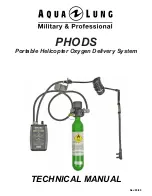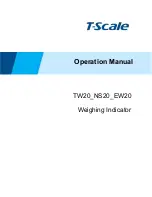
Page 25
8-9 Strobe Wiring
8-9.1 Strobe Wiring (RS232, 25 Pin Connector)
The 3 data lines are hooked up to Pins 9, 10, and
11. These lines must be held high while a strobe
of at least 25 milliseconds is given on Pin 18.
Data is transmitted in RS232 serial format on the
Transmit Data Line (Pin 3).
a) Pin 9, Binary 1's Input
b) Pin 10, Binary 2's Input
c) Pin 11, Binary 4's Input
d) Pin 18, Strobe Input
e) Pin 3, Transmit Data
f) Pin 7, Signal Ground for Reference
Refer to 8-5.1 Wiring Hookup RS232 / Strobe (25
Pin Connector) for diagram.
8-9.2 Strobe Wiring (RS422, 37 Pin Connector)
The 3 data lines are hooked up to Pins 9, 10, and
11. These lines must be held high while a strobe
of at least 25 milliseconds is given on Pin 3. Data
is transmitted in RS422 format on the Transmit
Data Line (Pins 6, 24).
a) Pin 21, Binary 1's Input
b) Pin 14, Binary 2's Input
c) Pin 10, Binary 4's Input
d) Pin 3, Strobe Input
e) Pins 6, 24, Transmit Data
f) Pins 19, 20, Signal Ground for Reference
Refer to 8-7.1 Wiring Hookup RS422 / Strobe (37
Pin Connector) for diagram.
8-10 Serial Interface Operation
Data is received and transmitted over standard
EIA RS232 or RS422 levels. To address a Unit,
transmit a "D" (device) followed by the 1 to 15
code number and a "Space". Once the space has
been received The Unit becomes active and
responds back, "Device XX:" (Device number).
(Once active, the unit works in a full duplex echo
back mode, so that data sent from
the terminal will be transmitted back for
verification.) Once the unit is "on line", use the
proper serial transmit codes to request data or set
a new value. (See Section 8-10.2 RS232/RS422
Serial Input Codes). Up to 80 characters of data
may be linked together and transmitted to The
Unit (as long as there is a space between the
different codes). If an error is made, a correction
can be made by back spacing and retyping correct
data before the "Carriage Return" (Enter) is sent.
Once "Carriage Return" (Enter) is sent, the unit
starts processing the data and will transmit the
requested data on a non-priority basis over the
data transmit line. A Unit keypad entry or
incoming data will halt the data communication
cycle. Therefore, there should be a pause after
data is requested to insure that all data has been
transmitted before another unit is addressed and
brought on line. When transmitting, the unit will
precede each data value with a "Carriage Return"
and "Line Feed" code and answer only with
requested data in the order the requests were
made. After all requested data has been
transmitted any new communication must be
started again by DXX (Device number) and space.
8-10.1 Serial Communications Timing.
If The Unit is not busy, it should not require more
than 5 msec to process each request. To find the
cycle time to process and transmit a request,
calculate the bit transmit time by dividing 1 by
the baud rate; multiply that by 80 (8 characters
each; 10 bits per character); add 5 msec. to this
product and multiply by the number of requests
made. Example: Typical time to transmit 1
uninterrupted request at 300 baud rate is .272 sec
= (1
÷
300) x (80) + 0.005. This time will be
extended if The Unit must service the front
keypad or one of the inputs. In practice, if
transmission has not started within 2 seconds
after data is requested, it can be assumed that
there is a problem.
Summary of Contents for KEPtrol F/C
Page 4: ...THIS PAGE IS BLANK...





































